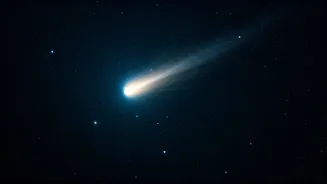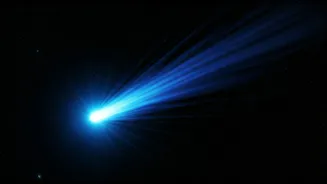A Rare Cosmic Guest
The Atlas comet, designated as 3ai/Atlas, became a focal point for astronomers. It offered a unique chance to study the chemical makeup of another star
system. The comet's arrival and trajectory captured the attention of both space agencies, NASA and ESA, as they initiated and coordinated efforts to observe and analyze it. This interstellar visitor offered a rare glimpse into the distant cosmos. This event provided scientists with a valuable opportunity to learn more about the formation and composition of celestial bodies beyond our solar system, with potential insights into the origins of our universe.
Tracking and Observation
NASA and ESA employed advanced technologies and methodologies to track the Atlas comet. They established live trackers to provide real-time updates on its position. These trackers were crucial for monitoring the comet's movement and predicting its closest approach to the Sun. Such data was important for scientific analysis. Astronomers were able to optimize the placement of telescopes and other instruments to observe the comet. These live trackers were essential for maximizing observation opportunities. This also helped in coordinating observations among scientists across the globe, allowing for more comprehensive data collection and analysis. The use of specialized equipment was key.
Closer to the Sun
The most anticipated part of the comet's journey was its closest approach to the Sun. During this time, the comet was intensely observed and studied. This near encounter allowed researchers to study the comet's behavior when exposed to extreme solar radiation. It also offered excellent chances to observe its tail and coma. It was possible to examine the way the comet's ice and dust reacted to the Sun's heat. These observations were valuable for learning about cometary activity and other characteristics. During the closest approach, scientists and astronomers turned their telescopes toward the heavens.
Unveiling Star Secrets
The Atlas comet offered a unique opportunity to understand the chemistry of another star system. Through extensive data collection and analysis, the teams aimed to determine its composition. By analyzing the light reflected and emitted by the comet, scientists could ascertain the presence of various elements and molecules. It also allowed them to understand the conditions in the comet's origin star system. This involved examining spectra of light, looking for specific spectral lines. These lines were like fingerprints that told scientists which elements and compounds were present. This research could add to our understanding of how star systems, including our own, are created and developed.
Visibility and Location
The visibility of the Atlas comet was a key topic of interest for both professional astronomers and stargazers. Observing the comet depended on the observer’s location on Earth, the time of the year, and the comet's position in the sky. The live trackers provided details on its real-time location and forecasts for visibility. They helped people to find the comet. Astronomers shared this information widely so that anyone with the proper equipment and clear skies could watch this event. Tracking information was provided to allow for the best viewing conditions. They provided details on the best vantage points and the optimal times for observing the comet.











